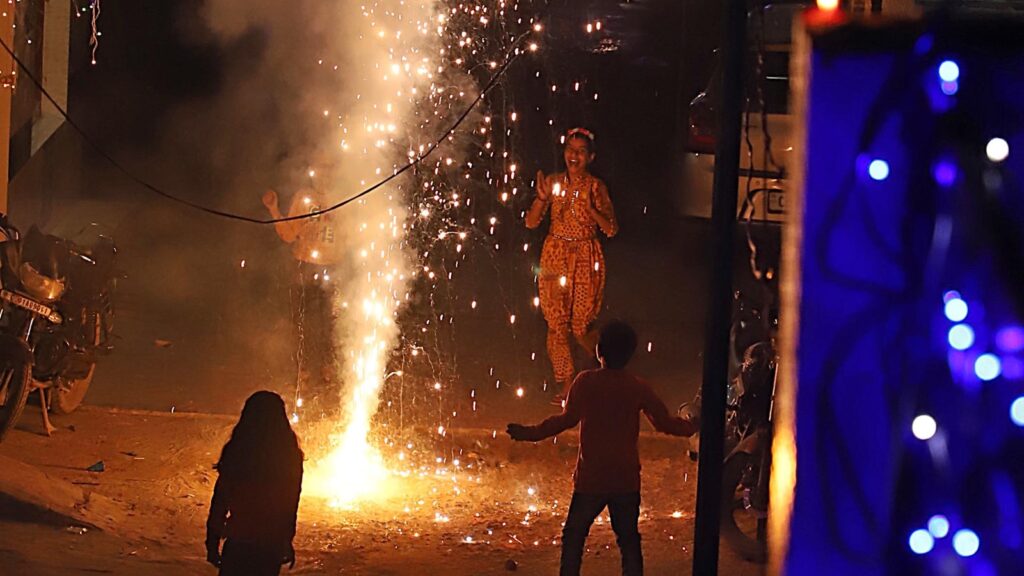Each winter, as lights begin to glimmer across Delhi’s balconies and lanes, another familiar sight descends — a dense, grey haze wrapping the city in a smoky mask.
Diwali in the national capital has, for years, been as much about lamps and festivities as about air purifiers and court orders. This year, as the BJP celebrates its return to power in Delhi after 27 years, the festival comes with a test that goes beyond fireworks, balance faith, optics, and the fight against pollution.
On Wednesday, even as Delhi’s Air Quality Index (AQI) crossed 300 and the haze began to thicken, the Supreme Court allowed the sale and use of green firecrackers for the first time since a complete ban was imposed in 2020. The relaxation, limited to two days and fixed hours, was welcomed by Delhi Chief Minister Rekha Gupta, who called it a “balanced” move between “tradition and environment”.
For a party that has long accused the Aam Aadmi Party (AAP) of “weaponising” pollution politics and “hurting Hindu sentiments,” the apex court’s decision now brings a test of its own for the BJP.
In AAP-ruled Delhi, a blanket ban on firecrackers had been in place since 2020, extended each year by the court as part of its winter pollution control strategy. AAP had defended it as a “public health necessity” but often faced backlash from the BJP for being “too restrictive” during Diwali.
For nearly a decade, Delhi’s festive air has been shaped as much by fireworks as by court orders, many of them coming just days before the festival. The first major intervention came in 2017, when the Supreme Court banned the sale of firecrackers across the National Capital Region (NCR) to control post-Diwali smog. A year later, it softened its stance, allowing “green crackers” for limited hours, provided they met chemical and emission standards verified by the Petroleum and Explosives Safety Organisation (PESO).
But enforcement seemingly faltered. In 2018, the police struggled to tell the difference between certified “green” crackers and traditional ones, leading to widespread violations. The National Green Tribunal (NGT) stepped in and imposed a blanket ban on firecrackers in 2020.
The latest ruling marks the first time since then that the apex court has upheld states’ powers to permit crackers based on air quality, giving Delhi a conditional nod to celebrate with fireworks again. But in a city where AQI often breaches 400 by early November, the question remains: will enforcement finally match judicial intent?
The AAP has been quick to turn the decision into a political flashpoint. Former Environment Minister and Babarpur MLA Gopal Rai — who has been focused on AAP’s pre-election outreach in Gujarat — returned to Delhi to welcome the conditional approval but also warned the BJP government against risking another pollution crisis.
“In 2018, similar permission for green crackers was granted, but due to the Delhi Police’s negligence, serious violations occurred, leading the NGT to impose a complete ban in 2020,” he said.
Rai also accused the Gupta government of being unprepared for Delhi’s annual smog season. “Half of October has already passed, yet no Winter Action Plan has been announced,” he said.
For the BJP, the festival is about ensuring that its decision does not invite the same scrutiny it once directed at its rival. The party has long argued that Diwali crackers are being unfairly blamed for Delhi’s pollution, a sentiment that resonates with many of its traditional supporters. Yet, it also built one of its major electoral promises around cleaner air.
In its Viksit Delhi Sankalp Patra 2025, released before the Assembly elections, the BJP pledged to halve Delhi’s PM2.5 and PM10 levels within five years and launch a Delhi Clean Air Mission to reduce the city’s average AQI by 2030. The manifesto promised road-sweeping machines in every Assembly constituency, water sprinklers in every municipal ward, and intensified clean-up drives in highly polluted areas such as Anand Vihar and Mundka.
On the campaign trail, senior BJP leaders such as Union Minister Nitin Gadkari also promised cleaner air. “If you install a BJP engine in the city government, we will free Delhi from traffic jams and air pollution within five years. I give my word,” he had said.
In November 2024, when Delhi’s air turned toxic and AQI breached the “severe plus” category, the party had mocked AAP’s handling of pollution with a social media campaign titled “Dilli mein saanson ka Apaatkaal (an emergency of breath)”. Posters showing former Chief Minister Arvind Kejriwal masked against the smog, under the tagline “AAP Entertainment Presents”, were splashed across the city and online.
Now, the challenge for the BJP is twofold: to prove that its “four-engine government” — at the Centre, the LG’s office, the MCD, and the Delhi government — can coordinate where AAP allegedly failed, and to manage the optics of a decision whose absence could have alienated its pro-cracker base.
The Supreme Court’s ruling has also placed the on-ground responsibility squarely on the Delhi Police, which reports to the BJP-led Centre. Crackdowns on illegal stockpiles, verifying PESO-certified supplies, and enforcing strict bursting hours will determine how clean or smoggy Delhi’s first BJP-ruled post-Diwali morning will look.

